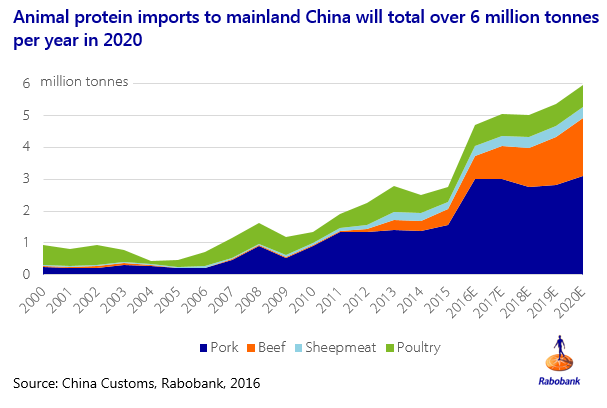Rabobank’s new report on the outlook of China’s meat industry up to 2020 highlights some of the key meat trends in the world’s second-largest economy.
One thing is clear about China’s meat industry for the next three years: meat imports for beef, pork and poultry are expected to continue rising, cementing China’s position as the most important meat trader in the world.
If it is not already, China will be the focus for meat exporters everywhere. But as the country’s single-digit economic growth slows, meat demand will cool, leading to a period of change.
‘Uncertainty’
“On the supply side, pork production will be reshaped, while poultry production faces uncertainty, and beef production will likely drop,” said Chenjun Pan, China-based senior analyst of animal protein at Dutch firm Rabobank.
“As a consequence, meat imports are expected to increase steadily, further cementing China’s role as the world’s most significant meat importer.”
On pork, the next three years will see production bases spring up in the north and the north-east. In the south, home to many rivers and lakes, construction of pork production factories will be limited.
Small producers and farmers could be squeezed out of the market, with further consolidation of larger companies. Pork is strategically import for the Chinese government. The introduction of an environmental tax suggests the government wants production to conform to environmental sustainability as China looks to lead the world on the Paris Agreement on climate change.
When it comes to beef production, a fall is expected this year, followed by two years of 1-2% growth. Consumer demand, especially from middle and high-income households, is expected to outpace domestic production, leading to a boom in beef imports. By 2020, imports will make up more than 20% of the country’s beef supply.

China’s ongoing reliance on imports of white-feathered breeding stock makes the country’s poultry supply chain vulnerable to trading changes, Rabobank claims. Due to trade restrictions imposed on some of its biggest suppliers – the Netherlands and Germany – over Europe’s H5N8 avian influenza outbreak, China’s poultry production will fall in 2017.
Change across beef, pork and poultry will see varying levels of flux in Chinese meat production, but consumers will buy more meat than the country can produce. Imports will continue to rise.
Rabobank estimates meat imports to mainland China will reach 6m tonnes in 2020, firming up the country’s position as a dominant player in the global meat industry.
